A
STAR IS BORN
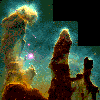
|
FUNNEL
CLOUDS IN SPACE
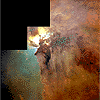
|
DYING
IN COLOR

|
| Towers
of sculpted gas in the Eagle nebula (M16) are actually
cocoons for embryonic stars. |
Giant
funnel-shaped clouds of gas (upper left) were captured
in another stellar "maternity ward," the Lagoon nebula
(M8). |
Rings
of gas surround the dying star NGC 6543, nicknamed the
Cat's Eye. |
STELLAR
EXHAUST

|
A
"ZOOM LENS" IN SPACE
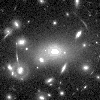
|
COSMIC
COLLISION CREATES STARS

|
| The
dying star M2-9 is nicknamed the Twin Jet nebula because
the two tubes of gas streaming from it behave like exhaust
from a jet engine. |
The
arc-like pattern spread across the picture like a spider
web is an illusion caused by the gravitational field of
a cluster of galaxies called Abell 2218. This process,
called gravitational lensing, magnifies, brightens, and
distorts images of objects that lie far beyond the cluster,
providing a powerful "zoom lens" for viewing galaxies
that are so far away they could not normally be observed
with the largest available telescopes. |
A
collision between two spiral galaxies has spawned brilliant
bursts of star birth. |
BALLOONS
OF GAS
.gif)
|
GASEOUS
"HULA-HOOPS"
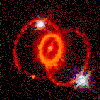
|
GALLERY
OF GALAXIES
.gif)
|
| A
pair of billowing dust and gas clouds have been cast off
by the massive dying star Eta Carinae. |
A
large pair of gaseous rings frame a glowing halo of gas
surrounding the massive dying star Supernova 1987A. |
Hubble
peers back more than 10 billion years to reveal at least
1,500 galaxies at various stages of development. |
SATURN'S
LIGHT SHOW
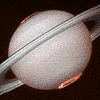
|
HOW'S
THE WEATHER?
.gif)
|
FOOD
FOR A BLACK HOLE
.gif)
|
| Saturn's
north and south poles display spectacular oval-shaped
curtains of light, called auroras, which were captured
in ultraviolet light by Hubble's Space Telescope Imaging
Spectrograph (STIS). |
Hubble
has been used to monitor weather conditions on Mars. |
A
spiral-shaped disk of dust is feeding a massive black
hole in the galaxy, NGC 4261. |